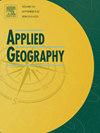The spatial distribution and synergistic effect of different innovation activities in Chinese cities: An analysis based on technology, design, and market activities
IF 4
2区 地球科学
Q1 GEOGRAPHY
引用次数: 0
Abstract
This study analyzes the spatial distribution and synergies of technology, design, and market innovation in Chinese cities using data on invention patents, design patents, and trademarks from 296 cities at the prefecture level and above from 2014 to 2022. It focuses on innovation disparities across regions and city sizes. The findings reveal a positive correlation between innovation intensity and both city population size and GDP per capita. Large-scale and eastern cities excel in three types of innovation activities, but innovation differences between cities become balanced as the gap in market innovation gradually narrows. Technology innovation is a key driver of new technology, new design, and new market specialization, and its relatedness and cross-relatedness are the most significant drivers of innovation specialization. Additionally, the synergies of innovation activities show significant heterogeneity across regions and city sizes: in western cities, technology-market cross-relatedness has a stronger impact on new market specialization than in eastern and central cities. The influence of technology relatedness on new technology and new market specialization gradually strengthens as cities shift from east to west and from large to small and medium-sized cities. This study offers new insights into China's urban innovation disparities and provides implications for policy making.
求助全文
约1分钟内获得全文
求助全文
来源期刊

Applied Geography
GEOGRAPHY-
CiteScore
8.00
自引率
2.00%
发文量
134
期刊介绍:
Applied Geography is a journal devoted to the publication of research which utilizes geographic approaches (human, physical, nature-society and GIScience) to resolve human problems that have a spatial dimension. These problems may be related to the assessment, management and allocation of the world physical and/or human resources. The underlying rationale of the journal is that only through a clear understanding of the relevant societal, physical, and coupled natural-humans systems can we resolve such problems. Papers are invited on any theme involving the application of geographical theory and methodology in the resolution of human problems.
 求助内容:
求助内容: 应助结果提醒方式:
应助结果提醒方式:


